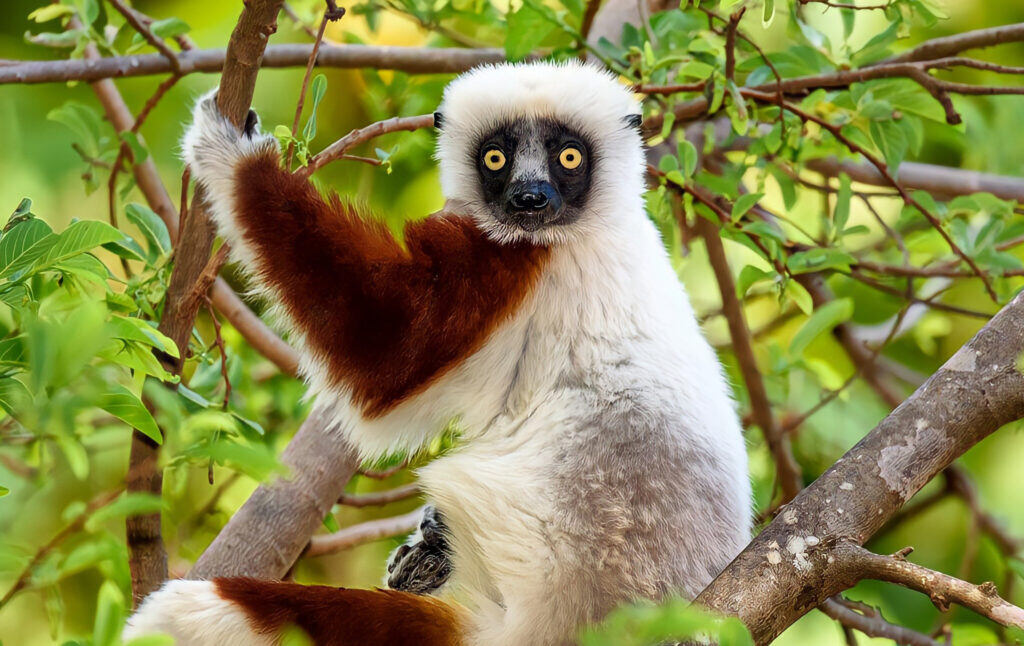
The Last Great Forests
What’s left of Madagascar and its extraordinary rainforest can tell us a great deal about the history of the climate crisis, as well as the forces we’re up against.
At first glance, the Cotswold Wildlife Park in Southern England seems like little more than a glorified zoo. But my partner and I needed some animal time, so we decided to check it out—and were surprised to have had one of the most fun days we’ve enjoyed in recent memory. There were moments of extraordinary wonder. We’d never before been so close to penguins, who walked around in the open air just beyond a three-foot-high wall (from which they are too little to escape). In another part of the park, a family of capybaras sat on the other side of a short, chain link fence, making strange high-pitched noises, sounding more like robot birds than giant rodents. We stood on a platform and a giraffe brought his face up to mine. The awe of that encounter was unlike anything else: I can only compare it to the scene in Jurassic Park where the scientists stop their jeep to see a living brachiosaurus for the first time.
But the highlight of the day was the Madagascan walkthrough. In this area, you enter an enclosure with a high net for a roof, but no cages. Inside, many lemurs bound around freely, inches away, mostly ignoring the people gawking at them. There is nothing between you and the animals except the echoing words of the weary keeper who reminds you that you’re not allowed to cuddle the lemurs (“if I don’t get to, you certainly don’t get to,” she told us). Most of the lemurs in the enclosure were the familiar ringtails and brown bamboo lemurs. But there was one oddball who really stood out: a crowned sifaka—a species of the Propithecus genus of lemur—named Maitso. His name means “green” in the Madagascan language Malagasy, but it’s only his eyes that are bright green: his fur was cream-colored with a black face and chest, and shoulders like copper. His build was quite different from the smaller and more cat-like ringtails; being adapted to leaping from tree to tree—sometimes as far as thirty-feet in a single bound—sifaka’s long arms and legs are awkward on the ground, so when they have to leave the trees, they bounce along in a bipedal, sideways hop.
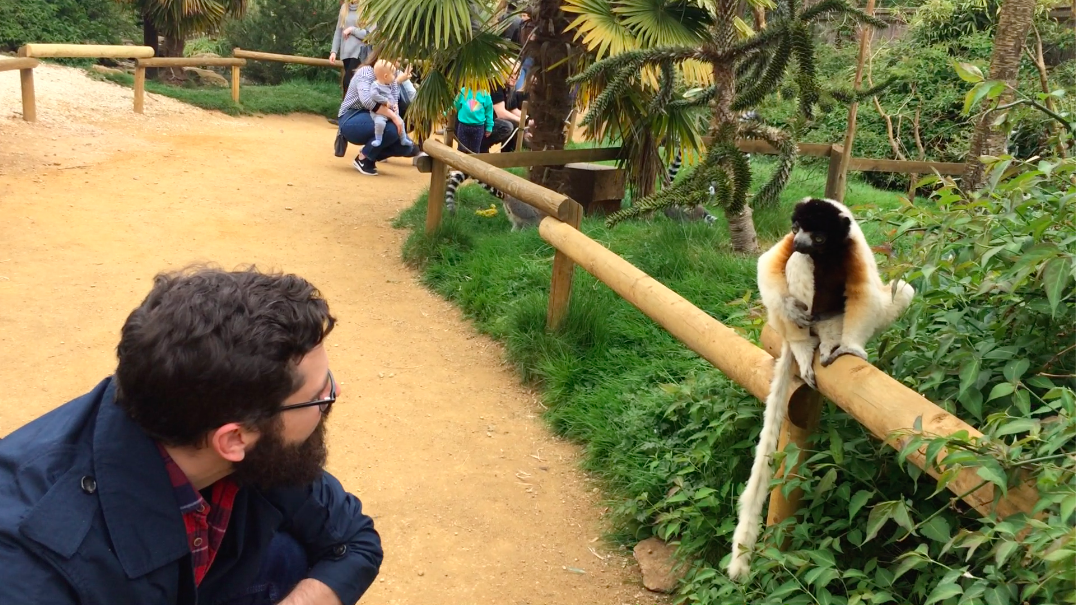
At one point, Maitso approached a troop of ringtail lemurs who were huddled together. He sat upright like a small person, his long arms clasped around his knees, studying them. Slowly he inched toward the ringtails, scooting closer on the grass, casually looking away as if he were uninterested in their business. When he got close enough he hesitated, then moved his face up to one of them. The other animal noticed him, and closed in as if considering a kiss. As soon as he started licking their face, however, a different ringtail smacked Maitso and he recoiled; falling back a little, he resumed holding his knees and sitting placidly. A little later, he tried again and got in a few brief licks on the face of another ringtail before a quick motion made him back off. At this point, he shifted his interest to a nearby stick. Sifakas are incredibly social creatures with a need to groom; it is not anthropomorphizing to assume Maitso was seeking affection and comfort. With his awkward socializing, upright sitting posture, and bipedal hop, it was hard not to see an eccentric person, perhaps grown mad and lonely in the company of these sometimes hostile ringtails, trapped together in a relatively small area under a net. The staff person warned us to be careful entering and exiting the enclosure as Maitso had a taste for the plants nearby and was a master escape artist.
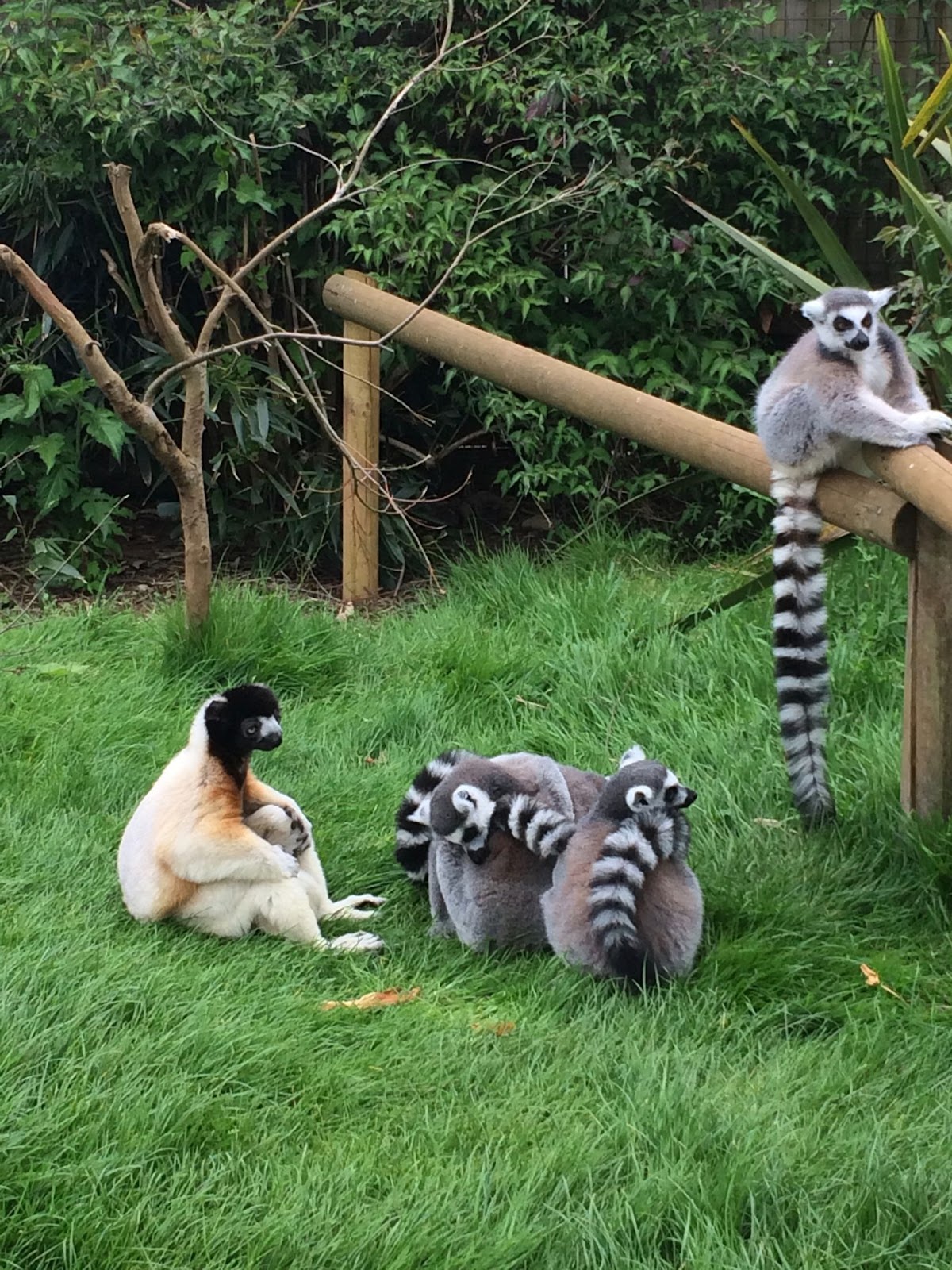
According to National Geographic, lemurs are the most endangered vertebrates in the world. In the wild, sifakas live on a few patches of land in Madagascar, and nowhere else. All sifaka species are critically endangered because, in addition to being poached for pet trafficking and meat, their habitats are rapidly shrinking as humans deforest Madagascar and the planet.
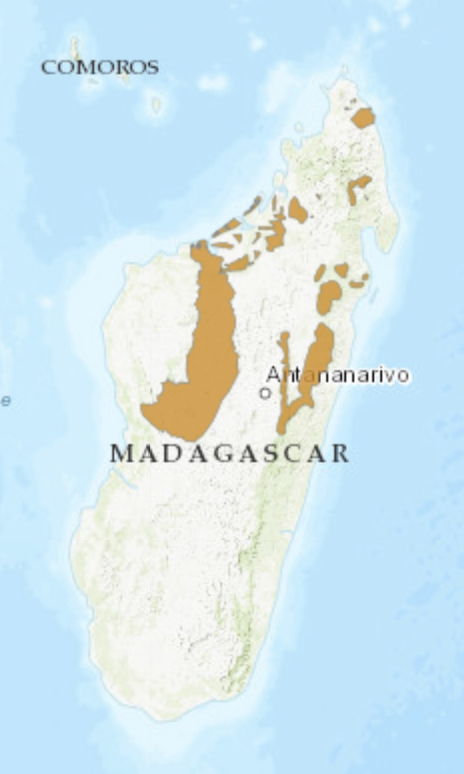
Worldwide, forest destruction is occurring rapidly and accelerating: between 2002 and 2012, 18 million acres of forest were destroyed annually. A recent report found that rate to have increased by 52 percent: the scale of destruction is now 27 million acres per year. Madagascar and its wonderful, threatened sifakas provides a microcosm for understanding the global story of forest destruction:, its origins and its primary culprits.
The BBC reports that within the last 30 years or so, Madagascar has lost up to 80 percent of its original forest cover (though different studies disagree and the lower end estimate is 40 percent, and since 1950). Others posit that the island lost 70 percent of its forests in the early 20th century. Meanwhile, NASA cites figures suggesting that 94 percent of the island’s original forest has been “impacted” and 90 percent has been lost since the arrival of settlers 2,000 years ago (a vast majority of that portion in the last century or two). Whatever the case, it’s bad.


Humans have been present on Madagascar—the world’s fourth largest island—for at least 10,000 years. (Given that Homo sapiens evolved in Southern and/or Eastern Africa more than 300,000 years ago, and Madagascar is located at Africa’s southeasternmost point, it’s plausible that humans have been there much longer, but let’s stick with the evidence we have.) As far as we know, for 80 percent of that 10,000 years, human habitation in Madagascar had a negligible impact on its forests and its endemic species—the flora and fauna that live only in Madagascar, making up nearly 90 percent of its inhabitants and pre-dating even the oldest possible human habitation by quite a lot. You can imagine what it must have been like for Madagascar’s first people to come upon the island’s strange creatures: gasping at the sideways-leaping lemurs and the cat-like fossa, maybe even spotting the nano-chameleon, the world’s (so far) smallest reptile, first described by Western scientists only in February of 2021.
The original human inhabitants of Madagascar seem to have mostly or entirely practiced a foraging mode of production. Around 2,000 years ago, settlers from the Malay archipelago (modern Indonesia, East Malaysia, and the Philippines) arrived and began impacting the environment more intensively by cultivating agrarian and pastoral resources. They may have brought slavery to the island as well, in the form of captured Ma’anyan people, from an Indigenous culture native to Borneo. So the first culprit, reaching back to the roots of Madagascar’s deforestation, is a familiar one: a hierarchical settler kingdom.
Historian Gwyn Campbell contends that forest destruction really began at an industrial scale during the island’s (domestic) imperial period. The precolonial Merina Kingdom emerged in 1540, but Campbell dates its imperial period from 1790 until 1861. The Merina people, descending from a line of hereditary royals, occupied the top caste of the stratified kingdom and practiced endogamy (marrying within the caste). The empire used slave labor to clear forests and mine minerals including iron ore, which fed the empire’s economic growth. Slaves farmed not only food to feed the local populations, but also commodity crops like tobacco and cattle. In addition to enslaving people domestically, the empire was heavily involved in the international slave trade. While the country had long been exporting slaves to the international market, with the rise of the Merina Empire they beganimporting people for slavery as well. Imperial spoils, meanwhile, fueled an arms race—or storey race—of ever higher and more elaborate royal palaces, with the wealthier houses costing 100 times more than houses of the poor. In one particularly egregious case, the royalty conscripted a unit of 5,000 enslaved people to move a massive tree trunk into place to act as a palace pillar. Campbell quotes historian Raombana, a contemporary of the period, as noting: “Their pillars are enormous and has excited the astonishments of Europeans who has seen them… [sic] The getting and fetching of the enormous pillars and other Timbers for the construction of these Royal Houses fatigued the people very much.” Surely the fatigued people were reassured at having contributed to the progress and glory of the empire. As Campbell notes, during the period’s rule by Queen Ranavalona, a foreign-run leather tanning industry “fed by lime deposits […] and by fanompoana [slave] labour, resulted in such population growth that [the village’s] name was changed to Ambohimandroso (‘Village of Progress’).” All across the world, empires used slave labor to fell forests, fueling imperial growth with a degree of wantonness that could only be sanctioned by high-minded lies like human progress.
The French empire used this tactic too in many countries, and also played a critical role in the environmental devastation of Madagascar. After two wars with the Merina rulers, the French succeeded in colonizing the island in 1897 until it gained independence in 1958. Historical geographer Lucy Jarosz points to colonial policies as a major driver of deforestation during this period. She argues that from the beginning of the French administration, agricultural production was “geared primarily for export,” emphasizing coffee, rice, and beef, with “coffee cash cropping” decimating forests. These policies were rooted in the idea of modernizing the colony in the name of progress, “civilizing” what the French administrators considered savage practices. After a tour of the subsistence cultivation taking place throughout the countryside—by this point a more nomadic and haphazard form after wars and the Merina imperial collapse—a French Lieutenant Michel recommended “strong penalties to stop what he portrayed as a barbarous and deplorable [agricultural] practice.” This supposedly barbarous practice involved a set of slash-and-burn techniques that could clear large patches of forest at a time; the French government prohibited slash-and-burn completely in 1913 and sought to replace it with more “modern” and intensive forestry and agricultural techniques. But these reforms were not ecologically informed, failing to take into account natural barriers like the country’s micro-climate.

What was perhaps meant to be a well-meaning, sustainable intervention was undermined by the colonial administrators’ ecological ignorance. Jarosz suggests that as much as 70 percent of Madagascar’s remaining primary forest was harvested during the colonial period “due to the state’s economic objectives.” Though the precise proportions of forest clearance are conflicting, a general pattern emerges. In fact, we can extrapolate this pattern to many other places around the globe:
- Foragers and small agrarians cause little deforestation or habitat destruction, even over the course of thousands or tens of thousands of years.
- Expansionist empires arrive, either within state borders or from without, and increase deforestation practices with promises of modernization, glory, and progress.
In the late 20thtwentieth century decolonization movements (in most places) ostensibly shake out the crusty old European imperial administrations from their former colonies and newly independent states. However—deforestation accelerates.
Why, even after liberation from colonization, would deforestation continue and with increasing rapidity? The answer is once again rooted in progress narratives, growth imperatives, and hierarchical governments focused on maximizing extraction. The primary culprit is the economic liberalization process that spread across the world in the latter half of the 20thtwentieth century with the rise of organizations like the International Monetary Fund (IMF), the World Trade Organization (WTO), and the World Bank. These international institutions encouraged the opening of trade borders, which meant that countries with what capitalists had previously considered un- or under-exploited resources like rainforests suddenly became flooded with money from investors interested in replacing rainforests with, say, oil palm plantations, the products of which can be sold to consumers in beloved products like Nutella.
In Madagascar specifically, the country took its first IMF loan in 1977, and the IMF continued lending to the country for the next 50fifty years. In 1982, after Keynesian influences had been eliminated from the organization, the IMF—along with the World Bank—became, in the words of geographer David Harvey, “centres for the propagation and enforcement of ‘free market fundamentalism’ and neoliberal orthodoxy.” The loans to Madagascar were granted with concessions that required the country to privatize resource access and encourage foreign investment. In 1987, the IMF imposed one of its infamous “structural adjustments” on Madagascar, which required countries to implement policies that impose harsh austerity measures, deregulation, and decrease taxes on corporations. According to political science professor Caroline A. Hartzell (and her colleagues), these programs “systematically create new economic winners and losers rather than particular levels of economic openness…” finding also that “governments that adopt an IMF-led path to liberalization are likely to be at greater risk for experiencing the onset of civil war.”
Madagascar is currently suffering just such a civil crisis. In 2009, the country’s elected president was ousted in a military coup that arose from of a combination of factors, including the impacts of the devastating Cyclone Kesin (itself likely exacerbated by global warming) as well as long-standing political tensions and economic policies like the IMF’s structural adjustments.
Meanwhile, demand in China has made Madagascan rosewood the most trafficked wild product in the world; illegal logging of rosewood is a major contributor to the island’s rapid deforestation. European and American demand for wood furniture and instruments is also part of the problem, as is illegal mining. Population growth has added pressures, particularly given the island nation’s fixed ecological boundaries. Marginalization of Indigenous agricultural and forestry practices has contributed to negative environmental impacts; climate change and aridization further devastate the country, with previously forested areas drying up and fertile soil washing out to sea.
The political crisis has opened up opportunities for poachers and illegal loggers to invade protected areas and subjugate the people who live there. An update on the website for the Marojejy National Park from March of 2009 offers a chilling glimpse of conditions there:
It is with great sadness that we report the temporary closure of Marojejy National Park to tourism. The closure was deemed necessary by park management due to the lawlessness that has descended over the SAVA region during this time of political unrest in Madagascar, and the resultant looting and destruction which is currently occurring within the park. In particular, gangs of armed men (led primarily by foreign profiteers [primarily from China] in conjunction with the rich local mafia) are plundering the rainforests of Marojejy for the extremely valuable rosewood that grows there….While old-growth rosewood trees may be the primary objective of the armed gangs, such destructive, unregulated use of the forest will certainly have an adverse effect on everything else in the park. Most worrisome is the well-being of the highly endangered Silky Sifaka, a lemur found only in the rainforests of Marojejy and the surrounding area….With armed militia descending on local villages and death threats being issued, people live in fear; communities are divided, and families are pitted one against the other.
In an update posted a month later, the site describes the “rosewood mafia” setting up heavily armed camps in broad daylight, “threatening villagers and bribing local policemen,” to haul “tons upon tons” of rosewood out of the park. Meanwhile, “large-scale, organized” bushmeat hunters set packs of trained dogs on sifakas and other lemurs to kill and sell in markets throughout the country. Environmental policy professor Annah Lake Zhu attributes growing demand for rosewood in China primarily to capital accumulation: “Chinese investors have increasingly turned to rosewood and other culturally important endangered resources…as a new outlet for the accumulation of surplus value.” That is to say, these investors are participating in a long lineage of cutting down Madagascar’s rainforests to hoard wealth. And although the French abolished Madagascar’s participation in the slave trade, part of the Empire’s modernization and great contribution to human progress, it did not end forced labor—perhaps unsurprisingly, most of it was simply moved to French plantations—which has continued to exist into the present amid the political crisis and scramble for resources.
On top of everything else, the climate crisis is already hitting Madagascar hard. The climate change-exacerbated drought currently gripping the country is the worst in 40forty years, and threatens a million people with starvation. Such impacts will only intensify as the world warms. If these elements continue—if growth and liberal “progress” proceed apace—then sifakas, and much of Madagascar’s other endemic wildlife, will surely go extinct. And soon. While climate change gets most of the coverage, the extinction crisis entails equally apocalyptic consequences. The rainforests are just the frontline trenches of this emergency.
The World Bank has also lent to Madagascar and recently touted the country’s rapid economic growth over the last five years. Meanwhile, Madagascar remains one of the poorest countries in the world and one of the most deforested. The essential neoliberal promise—still driving policy today—that economic growth trickles down to improve poverty is clearly false, and the experience of Madagascar is one among many case studies. “Growth” is a euphemism that sanitizes the process of multinationals and richer nations plundering a country’s natural resources.
Elsewhere in the world, three major rainforests are still intact: the Amazon, the Congo Rainforest and Basin, and Borneo (the world’s third largest island) in the Malay Archipelago. Twenty-percent of the Amazon has been destroyed since the 1970s; the rest is very near thresholds that, if crossed, will send it into an inescapable death spiral, ensuring its collapse by the 2060s. Thanks to the forces of economic liberalization, the Amazon is now a net-emitter of CO2 rather than a carbon sink, releasing nearly 20 percent more CO2 than it absorbed over the last decade. Between 2000 and 2010, the Congo Basin lost 700,000 hectares—about the square mileage of Delaware—per year, and the deforestation rate has slowed only moderately since then. One study predicts its demise by 2100. Nearly half of the forest cover in nearby Nigeria was destroyed in a 10ten-year timespan—between 2007 and 2017—much of it for charcoal sold in local and international markets. In Borneo, an area the size of Belgium was illegally logged between 1985 and 2001, and at approximately the same time, oil palm production grew by an order of magnitude, from 600,000 to 6 million hectares. Palm oil has become a cheap, efficient, and versatile source of vegetable oil; it can be found in about half of supermarket products from food to toothpaste, and also in animal feed and biofuels. Oil palm plantations are not a substitute for rainforest nor examples of “reforestation.” They’re chemical deserts. According to one study: “The island of Borneo as a whole seems to have reached a level of forest degradation that is beyond a point of no return,” when it comes to vegetation loss and carbon sequestration. Timber mafias illegally logging Borneo to feed international markets have been accelerating this collapse. As in Madagascar, the culprits in the destruction of these last great forests are industrial plantations (oil palm, rubber, and sugar) plus cattle farms, soy fields, biofuels, mining, wood harvested for furniture and global lumber markets, urbanization, and the familiar hunger of modern empires for annual growth and “human progress.” Residing in these rainforests and critically threatened with extinction are gorillas, chimpanzees, bonobos, and orangutans—human beings’ closest evolutionary relatives—as well as elephants, big cats, and tens of thousands of small species most of us have never heard of. If the world’s rainforests disintegrate into plantations, savannas, and deserts, we don’t know what to expect—it hasn’t happened while humans have existed—but, combined with status quo fossil fuel emissions, it could result in runaway climate change, droughts and evaporating food supplies, shifts in global weather patterns, and an irreparably deadened world. The destiny of Homo sapiens is intimately tied with that of the world’s rainforests. If they go, we may well join all the species we are currently in the process of extinguishing.
Indigenous people in these regions are also threatened with destruction, the destruction of their bodies and the extinction of their ways of life, which are just about the only methods human beings have ever successfully used to thrive without ruining the world around them. In Madagascar, defenders like Clovis Razafimalala, Armand Marozafy, Augustin Sarovy and many others have all fought to prevent environmental destruction and have been harrassed, jailed, and exiled. Across the world, defenders of land and forests are being murdered at record rates, records that are broken every year. While they represent just five5 percent of the global population, Indigenous people still control up to a quarter of the world’s total land area, two-thirds of which remains ecologically intact. As the United Nations Development Programme (UNDP) reports: “where indigenous groups have control of the land, forests and biodiversity flourishes.”
Neoliberalization has largely been a project of closing off previously free Indigenous land into plantations, pipelines, oil wells, compounds, and roads. The best way to protect those rainforests, endangered species, and Indigenous lifeways that still remain is to scale back activities associated with development and reverse this process, moving more land under the control of Indigenous groups while halting growth economies to the greatest extent possible. Economic policy has to be based on preserving and sustaining wilderness like forest lands and oceans, rewilding developed areas, and creating mutualistic relations between individuals and between peoples and the non-human world.

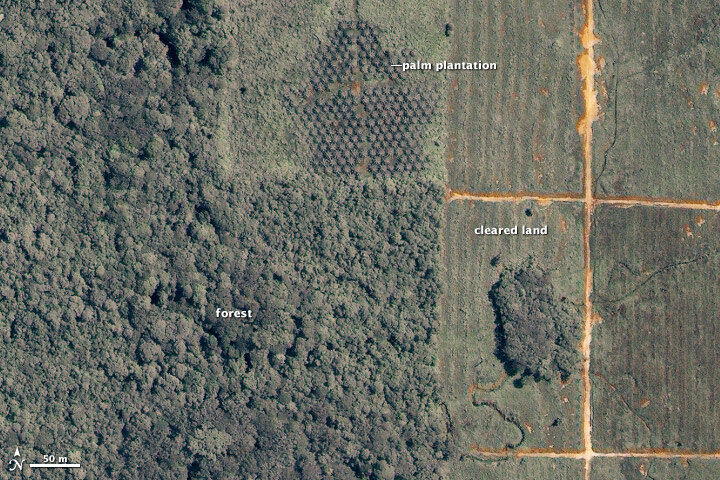
Environmental campaigner and Guardian columnist George Monbiot reminds us that the United Kingdom—the world’s ninth largest island—was once home to temperate rainforests (he also reminds us that “[o]ut of 218 nations, the UK ranks 189th for the intactness of its living systems.”) But the U.K. rainforests have long since been destroyed—a process probably beginning with the invasion of Rome, right around the time settler colonists first reached Madagascar. They could regrow over many decades or centuries, of course…if they were allowed to. Visiting the Cotswold Wildlife Park—perhaps itself occupying an area that was once a rainforest—inspired much wonder in us, but it was also sad. There was an irony in finding great joy from the presence of animals whose original homes are locked on course to resemble the denuded island they’re now stuck on, ghostly figures residing prematurely in the likely future of their native lands. Maybe the eccentric Maitso had gone mad, trapped in that net. He wasn’t the only one: many of the birds flew back and forth in their too-small enclosures. Wolverines, who normally range hundreds of solitary miles, bounded back and forth in a pen perhaps a hundred square meters in size. The giraffes lived in a (tall) barn. The thrill of being near these creatures could satisfy for an afternoon, but could not overcome our lingering anguish at their captivity, or the knowledge of many of their species’ imminent demise. Nor could it ever replicate the majesty of interacting with them in the wild, where they might not just be surviving on the brink of extinction, but thriving, happy. If we don’t immediately stop forest destruction and all the other ecological crimes currently underway, their joys and ours may soon be gone forever.




